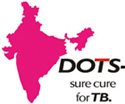
India is gearing up to strengthen tuberculosis (TB) control so as to provide TB prevention, diagnostics and treatment, particularly for multi-drug resistant tuberculosis (MDR-TB), nation-wide by 2010.
MDR-TB is TB that is resistant to at least two of the best anti-TB drugs, isoniazid and rifampicin. These drugs are considered first-line drugs and are used to treat all persons with TB disease.
"The 4th Global Survey on anti-TB drug resistance does not indicate that the rates of MDR-TB are increasing sharply in India or in Indonesia, or in the South-East Asian Region as a whole. The overall rates for MDR-TB among new smear-positive cases in the Region is 2.8% among new cases and 18.8% among people receiving prior treatment for TB for one month or more. However given population sizes in our larger countries, the numbers of cases are indeed large" said Dr Jai P Narain, Director, Communicable Diseases Department, South East Asian Regional Office (SEARO) of the World Health Organization (WHO).
MDR-TB is a result of inadequate programme performance of Directly Observed Treatment Short-Course (DOTS). DOTS is the WHO-recommended treatment strategy for detection and cure of TB which combines five elements: political commitment, microscopy services, drug supplies, surveillance and monitoring systems and use of highly efficacious regimes with direct observation of treatment.
"National TB control programmes in our Region have moved steadily to achieving the case detection and treatment success targets under DOTS. Treatment success rates in excess of 85% have been consistently achieved since 2002" further explains Dr Narain.
However due to a broad range of reasons, some people with drug-susceptible TB (which is not resistant to any anti-TB drug) develop resistance to anti-TB drugs, or may contract the drug-resistant strain of TB, which is also a possibility. People living with HIV (PLHIV) or those with compromised immunity are at particularly alarming TB risk (both drug susceptible and drug-resistant TB strains).
"MDR-TB cases arise among patients failing Category 1 and 2 regimens, contacts of MDR-TB cases, congregate settings and in other at risk populations such as PLHIV" adds Dr Narain.
Testing or diagnosing these drug-resistant strains of TB and providing effective medication (which is many times more expensive, and treatment duration is much longer) and improving DOTS programme performance for successfully diagnosing and curing drug-susceptible TB (and preventing development of any further anti-TB drug-resistance) can certainly make TB control more effective.
"We see this as an opportunity to strengthen our efforts to focus on prevention of MDR-TB so that we do not have to make the larger investments in treating additional cases of MDR-TB" says Dr Narain.
"India has adopted policy and is now rapidly building laboratory capacity through a network of 24 reference laboratories qualified to undertake culture and drug susceptibility testing (DST) to offer testing to all those who may have drug-resistant forms of TB. There is also an expansion plan to treat MDR-TB cases country-wide by the end of 2010" informs Dr Narain.
Dr Narain points out two specific areas that require attention: To determine how/ where MDR-TB is being generated, and to prevent further emergence of MDR-TB.
While achieving good cure rates under DOTS, we need to focus also on reasons for default and other unfavourable outcomes" says Dr Narain. "Given good cure rates under DOTS, are most MDR-TB cases arising from unsupervised treatment, through unsustainable out-of-pocket expenditure, outside of DOTS programmes?" asks he.
Dr Narain suggests some ways to prevent further emergence of MDR-TB. "By addressing all causes of adverse TB treatment outcomes, enhancing involvement of private sector and unlinked public health facilities, and promoting wider acceptance and application of the International Standards of TB Care" can possibly improve TB programmes in the region.
Amit Dwivedi
(The author is a Special Correspondent to Citizen News Service (CNS). He can be contacted at: amit@citizen-news.org)
|
|
Read More: East Godavari


Comments:
Nitika
September 22, 2008 at 12:00 AM
If you have more information on how MDR TB is generated please let me know.
I am a patient of MDR TB diagnosed in June08 in UK. I am resistant to all the first line drugs.I am a mumbaite and had moved to UK in august 07...at that time I was in best of my healths.
As a child I had primary infection and my mother remembers giving me some medicine for 90 days. I am 28 yrs old now. It bothers me alot that how did I get this infection...whether it was my primary infection that came back or did I get it from someone.
Can you let me know of some sources where I can discuss my case and solve this mystery of my life.
I am under treatment and isolation and very distressed , as now I have nothing else to do but to prevent the spread of this deadly bacteria which has caused complete chaos in my life.